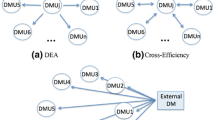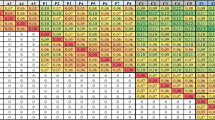Abstract
Despite the importance of knowledge transfer for firms involved in foreign direct investment activities, this area has not received appropriate attention from the perspectives of both the knowledge transferor (i.e., MNC parent) and the knowledge recipient. To fill in the gap in the current literature we propose a model to understand the links between criteria complicating the transfer of knowledge and preferences that the company has to focus. This model is based on both the existing literature as well as views of company representatives and provides a useful methodology for identifying decision making problems on the transfer of knowledge. In this paper, we investigate the fuzzy linear programming technique (FLP) to analyze these links and for multiple attribute group decision making (MAGDM) problems with preference information on criteria. To reflect the decision maker’s subjective preference information and to determine the weight vector of attributes, the technique for order preference by similarity to ideal solution (TOPSIS) developed by Hwang and Yoon (1995) and the linear programming technique for multidimensional analysis of preference (LINMAP) developed by Sirinivasan and Shocker (Psychometrica 38:337–369, 1973) are used.
Similar content being viewed by others
References
Almeida P., Kogut B. (1999) Localization of knowledge and the mobility of engineers in regional networks. Management Science 45: 905–917
Argote L., Ingram P. (2000) Knowledge transfer: A basis for competitive advantage in firms. Organizational Behavior and Human Decision Processes 82(1): 150–169
Argyris C., Schon D.A. (1978) Organizational learning: A theory of action perspective. Addison-Wesley, Reading, MA
Bjorkman I., Schaap A. (1994) Outsiders in the middle kingdom: Expatriate managers in Chinese-western joint ventures. European Management Journal 12(2): 147–153
Chen C.T. (2000) Extensions of the TOPSIS for Group decision-making under fuzzy environment. Fuzzy Sets and Systems 114: 1–9
Child J., Faulkner D. (1998) Strategies of cooperation: Managing alliances, networks, and joint ventures. Oxford University Press, New York
Cohen W.M., Levinthal D.A. (1990) Absorptive capacity: A new perspective of learning and innovation. Administrative Science Quarterly 35: 128–152
Davenport T.H., Prusak L. (1998) Working knowledge: How organizations manage what they know. Harvard Business School Press, Boston, MA
Dinur, A., Inkpen, A. C., & Hamilton, R. D. (1998). Knowledge transfer in the multinational corporation. In Paper presented at the Academy of International Business, Vienna, Austria.
Fan S.-K.S., Liang Y.-C., Zahara E. (2004) Hybrid simplex search and particle swarm optimization for the global optimization of multimodal functions. Engineering Optimization 36: 401–418
Gulati R. (1995) Does familiarity breed trust? The implications of repeated ties for contractual choice in alliances. Academy of Management Journal 38(1): 85–112
Gupta A.K., Govindarajan V. (1991) Knowledge flows and the structure of control within multinational corporations. Academy of Management Review 16(4): 768–792
Gupta A.K., Govindarajan V. (2000) Knowledge flows within multinational corporations. Strategic Management Journal 21: 473–496
Hakanson, L., & Nobel, R. (1998). Technology characteristics and reverse technology transfer. In Paper presented at the Annual Meeting of the Academy of International Business, Vienna, Austria.
Hamel G. (1991) Competition for competence and inter-partner learning within international strategic alliances. Strategic Management Journal 12: 83–103
Hwang, C.-L., & Chen, S.-J. (1992). Fuzzy attribute decision making: Methods and applications. In Collaboration with F.P. Hwang. Berlin: Springer.
Hwang, C. L., & Lin, M. J. (1987). Group decision making under multiple criteria, Lecture notes in economics and mathematics system (Vol. 281). Berlin: Springer.
Hwang C.-L., Yoon K.P. (1995) Multiple attribute decision making: An introduction. SAGE Publications, Thousand Oaks, CA
Lane P.J., Lubatkin M. (1998) Relative absorptive capacity and interorganizational learning. Strategic Management Journal 19: 461–477
Lane P.J., Salk J.E., Lyles M.A. (2001) Absorptive capacity, learning, and performance in international joint ventures. Strategic Management Journal 22: 1139–1161
Lei D.C., Slocum J.W. Jr., Pitts R.A. (1997) Building cooperative advantage: Managing strategic alliances to promote organizational learning. Journal of World Business 32(3): 203–223
Li D.F., Yang J.B. (2004) Fuzzy linear programming technique for multiattribute group decision making in fuzzy environments. Information Sciences 158: 263–275
Lyles M.A., Salk J.E. (1996) Knowledge acquisition from foreign parents in international joint ventures: An empirical examination in the Hungarian context. Journal of International Business Studies 27(5): 877–903
Mansfield E., Romeo A. (1980) Technology transfer to overseas subsidiaries by US based firms. Quarterly Journal of Economics 95(4): 737–750
Moreland R.L., Levine J.M., Wingert M.L. (1996) Creating the ideal group: Composition effects at work. In: Witte E.H., Davis J.H. (eds) Understanding group behavior: Small group processes and interpersonal relations Vol. 2. Erlbaum, Mahwah, NJ, pp 11–35
Nonaka I., Takeuchi H. (1995) The knowledge-creating company. Oxford University Press, New York
Nonaka I. (1994) A dynamic theory of organizational knowledge. Organization Science 5: 14–37
Roberts J. (2002) From know-how to show-how? Questioning the role of information and communication technologies in knowledge transfer. Technology Analysis & Strategic Management 12(9): 429–443
Ross T.J. (1995) Fuzzy logic with engineering applications. McGraw-Hill Inc, New York
Sirinivasan V., Shocker A. D. (1973) Linear programming techniques for multidimensional analysis of preferences. Psychometrica 38(3): 337–369
Spender J.-C. (1996) Making knowledge the basis of the dynamic theory of the firm. Strategic Management Journal 17: 45–62
Starbuck W.H. (1992) Learning by knowledge-intensive firms. Journal of Management Studies 29: 713–738
Szulanski G. (1996) Exploring internal stickiness: Impediments to the transfer of best practice within the firm. Strategic Management Journal 17(Summer special issue): 27–43
Tsang E.W.K. (2001) Managerial learning in foreign-invested enterprises of China. Management International Review 41: 29–51
Tushman M.L. (1977) Special boundary roles in the innovation process. Administrative Science Quarterly 22: 587–605
van Laarhoven P.J.M., Pedrycz W. (1983) A fuzzy extension of Saaty’s priority theory. Fuzzy Sets and Systems 11: 229–241
Wang P., Tong T.W., Koh C.P. (2004) An integrated model of knowledge transfer from MNC parent to China subsidiary. Journal of World Business 39: 168–182
Wang Y.M., Parkan C. (2005) Multiple attribute decision making based on fuzzy preference information on alternatives: Ranking and weighting. Fuzzy Sets and Systems 153: 331–346
Zadeh L.A. (1965) Fuzzy sets. Information and Control 8(3): 338–353
Zand D.E. (1972) Trust and managerial problem solving. Administrative Science Quarterly 17(2): 229–239
Zander, U. (1991). Exploiting a technological edge: Voluntary and involuntary dissemination of technology (p. 182). Stockholm: Institute of International Business.
Author information
Authors and Affiliations
Corresponding author
Rights and permissions
About this article
Cite this article
Albayrak, Y.E., Erensal, Y.C. Leveraging technological knowledge transfer by using fuzzy linear programming technique for multiattribute group decision making with fuzzy decision variables. J Intell Manuf 20, 223–231 (2009). https://doi.org/10.1007/s10845-008-0220-3
Received:
Accepted:
Published:
Issue Date:
DOI: https://doi.org/10.1007/s10845-008-0220-3




